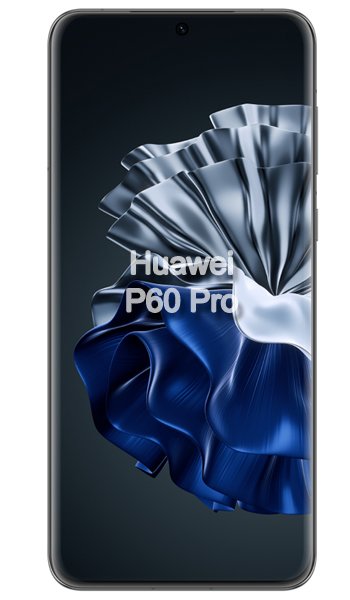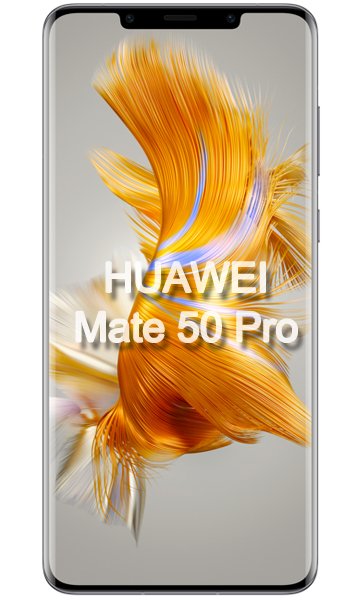Huawei P60 Pro vs Huawei Mate 50 Pro Comparison and Differences
Smartphone 1

Huawei P60 Pro
Smartphone 2

Huawei Mate 50 Pro
Smartphone 3
Differences between Huawei P60 Pro and Huawei Mate 50 Pro - Which to Choose?
Reasons to consider the Huawei P60 Pro:
- Newer Model: Released in March 2023, it's more recent compared to the Mate 50 Pro (September 2022), potentially offering more up-to-date technology.
- Battery Capacity: Slightly higher battery capacity of 4815 mAh compared to 4700 mAh in the Mate 50 Pro, which may offer slightly better battery life.
- Antutu Performance: Higher Antutu 10 total score (1,255,640) indicates potentially better overall performance compared to Mate 50 Pro's 1,130,696.
- Memory Options: Offers a variant with 12GB RAM, higher than Mate 50 Pro's maximum 8GB RAM, which can be beneficial for multitasking and high-performance tasks.
- Fast Charging: Supports faster wired charging at 88W, compared to 66W in the Mate 50 Pro.
- Screen Resolution: Higher screen resolution (1220 x 2700) than the Mate 50 Pro (1212 x 2616), which could mean a slightly sharper display.
- Camera Setup: Unique camera specifications with a 48 MP triple camera setup, potentially offering distinct photographic capabilities.
Reasons to consider the Huawei Mate 50 Pro:
- Price: Lower priced at 990 EUR compared to the P60 Pro’s 1200 EUR, making it more budget-friendly.
- Slightly Larger Screen: A marginally larger screen size of 6.74 inches compared to 6.67 inches in the P60 Pro, offering a bit more screen real estate.
- Build and Design: Different design options and build quality (not fully specified in the data provided) might appeal to different user preferences.
- Camera Megapixels: Higher primary camera resolution of 50 MP compared to 48 MP in the P60 Pro, which might translate to slightly better image quality.
- IP Rating: Superior IP68 dust/water resistance, withstanding up to 6m for 30 mins, compared to the P60 Pro's resistance up to 1.5m for 30 mins.
Additional Considerations:
Both phones lack 5G connectivity and a 3.5mm headphone jack.
Both use the same chipset and GPU, indicating similar processing and graphical performance.
Operating System: The P60 Pro comes with HarmonyOS 3.1 (China) or EMUI 13.1 (Europe), while the Mate 50 Pro has EMUI 13 (International) and HarmonyOS 3.0 (China).
The choice between the Huawei P60 Pro and Mate 50 Pro will depend on individual preferences for features like price, camera capabilities, battery life, and specific design elements. The P60 Pro offers a slightly better performance and battery, while the Mate 50 Pro is more budget-friendly with a larger screen and slightly better camera resolution.
Huawei P60 Pro or Huawei Mate 50 Pro Specs Comparison
 Common specs
Common specs
| Brand and model | Huawei P60 Pro | Huawei Mate 50 Pro | |
| Rating | (+3) | (+3) | |
| Release date | 2023, March 23 | 2022, September 06 | |
| Dimensions (HxWxD) | 161 x 74.5 x 8.3 mm | 6.34 x 6.34 x 2.93 in | 162.1 x 75.5 x 8.5 mm | 6.38 x 6.38 x 2.97 in | |
| Weight | 200 g | 7.05 oz | 205 g | 7.23 oz | |
| Body Build | Glass front, glass back, aluminum frame | ||
| Case | buy from Amazon | buy from Amazon | |
| Colors | Black, Green, Violet, Rococo Pearl | Black, Silver, Purple, Orange | |
| Battery | 4815 mAh, Li-Po, non-removable | 4700 mAh, Li-Po, non-removable | |
| Approximate price | 1200 EUR | 990 EUR | |
| Check price | from Amazon | from Amazon |
 Screen
Screen
| Technology | LTPO OLED | OLED | |
| Touchscreen | capacitive touchscreen | capacitive touchscreen | |
| Display colors | 1B | 1B | |
| Screen size | 6.67" in | 6.74" in | |
| Screen area | 107.7 cm2 | 111.8 cm2 | |
| Screen format | 19.5:9 (height:width) | ||
| Screen to body ratio | 89.8% | 91.3% | |
| Screen resolution | 1220 x 2700 px | 1212 x 2616 px | |
| Screen PPI /points per inch/ | 444 PPI | 428 PPI | |
| Screen protection | Kunlun Glass | Huawei Kunlun Glass | |
| Other specs | - 120Hz | - 120Hz | |
| Screen protector | buy from Amazon | buy from Amazon |
 Camera and Video
Camera and Video
| Rear camera, main | 48 MP, Triple | 50 MP, Triple | |
| Camera specs | -48 MP, f/1.4-f/4.0, 25mm (wide), PDAF, Laser AF, OIS -48 MP, f/2.1, 90mm (telephoto), PDAF, sensor-shift OIS, 3.5x optical zoom -13 MP, f/2.2, 13mm (ultrawide), AF |
-50 MP, f/1.4-f/4.0, 24mm (wide), PDAF, Laser AF, OIS -64 MP, f/3.5, 90mm (periscope telephoto), PDAF, OIS, 3.5x optical zoom -13 MP, f/2.2, 13mm, 120˚ (ultrawide), PDAF |
|
| Functions | LED flash, HDR, panorama | LED flash, panorama, HDR | |
| Video | 4K@30/60fps, 1080p@30/60fps, 1080p@960fps; gyro-EIS | 4K@30/60fps, 1080p@30/60/120/240/480fps, 720p@960fps, 720p@3840fps, HDR, gyro-EIS | |
| DxOMark Main Score | 156 | 149 | |
| DxOMark Photo | 159 | 152 | |
| DxOMark Video | 158 | 141 | |
| Front camera, selfie | 13 MP, Single | 13 MP, Single | |
| Specifications | 13 MP, f/2.4, (ultrawide) | 13 MP, f/2.4, 18mm (ultrawide) TOF 3D, (depth/biometrics sensor) |
|
| Functions | Panorama, HDR | HDR, panorama | |
| Video | 4K@30/60fps, 1080p@30fps | 4K@30/60fps, 1080p@30/60/240fps | |
| DxOMark Selfie Score | 145 | ||
| DxOMark Photo | 147 | ||
| DxOMark Video | 143 |
 Performance
Performance
| Operating system - OS | HarmonyOS 3.1 (China), EMUI 13.1 (Europe), no Google Play Services | EMUI 13 (International); HarmonyOS 3.0 (China) | |
| Chipset | - Qualcomm SM8475 Snapdragon 8+ Gen 1 4G (4 nm) | - Qualcomm SM8475 Snapdragon 8+ Gen 1 4G (4 nm) | |
| CPU | - Octa-core (1x3.19 GHz Cortex-X2 & 3x2.75 GHz Cortex-A710 & 4x2.0 GHz Cortex-A510) | - Octa-core (1x3.19 GHz Cortex-X2 & 3x2.75 GHz Cortex-A710 & 4x2.0 GHz Cortex-A510) | |
| GPU | Adreno 730 | Adreno 730 | |
| External memory | NM (Nano Memory), up to 256GB (uses shared SIM slot) | NM (Nano Memory), up to 256GB (uses shared SIM slot) | |
| Internal memory | 256GB 8GB RAM, 512GB 12GB RAM | 256GB 8GB RAM, 512GB 8GB RAM |
 Benchmark
Benchmark
| Antutu 10 Total | 1255640 | 1130696 | |
| Antutu 10 CPU | 355754 | 307526 | |
| Antutu 10 GPU | 475334 | 424162 | |
| Antutu 10 Mem | 193704 | 181742 | |
| Antutu 10 UX | 355754 | 307526 | |
| Antutu 9 Total | 989546 | 986456 | |
| GeekBench 5 Single Core | 1376 | 1266 | |
| GeekBench 5 Multi-Core | 4511 | 3938 |
 Communication and Connectivity
Communication and Connectivity
| SIM card | Single SIM (Nano-SIM)Hybrid Dual SIM (Nano-SIM, dual stand-by) | Single SIM (Nano-SIM)Hybrid Dual SIM (Nano-SIM, dual stand-by) | |
| Network | GSM / CDMA / HSPA / CDMA2000 / LTE | GSM / CDMA / HSPA / CDMA2000 / LTE | |
| Bands | -2G - GSM 850 / 900 / 1800 / 1900 - SIM 1 & SIM 2 (dual-SIM) CDMA 800 -3G - HSDPA 800 / 850 / 900 / 1700(AWS) / 1900 / 2100 CDMA2000 1x -4G - LTE |
-2G - GSM 850 / 900 / 1800 / 1900 - SIM 1 & SIM 2 (dual-SIM model only) CDMA 800 -3G - HSDPA 800 / 850 / 900 / 1700(AWS) / 1900 / 2100 CDMA2000 1x -4G - 1, 2, 3, 4, 5, 7, 8, 12, 13, 17, 18, 19, 20, 26, 28, 32, 34, 38, 39, 40, 41, 66 - International |
|
| Speed | HSPA, LTE-A | HSPA 42.2/5.76 Mbps, LTE-A | |
| GPRS | Yes | Yes | |
| Edge | Yes | Yes | |
| Wi-Fi | Wi-Fi 802.11 a/b/g/n/ac/6, dual-band, Wi-Fi Direct | Wi-Fi 802.11 a/b/g/n/ac/6, dual-band, Wi-Fi Direct, hotspot | |
| GPS | GPS (L1+L5), GLONASS (B1I+B1c+B2a), BDS (B1I+B1c+B2a), GALILEO (E1+E5a), QZSS (L1+L5), NavIC | Yes, with A-GPS. Up to tri-band: GLONASS (3), BDS (3), GALILEO (2), QZSS (2), NavIC | |
| NFC | Yes; NFC-SIM, HCE | Yes | |
| USB | USB Type-C 3.1, OTG | USB Type-C 3.1, USB On-The-Go, Display Port 1.2 | |
| Bluetooth | 5.2, A2DP, LE | 5.2, A2DP, LE |
 Music and Audio
Music and Audio
| Radio | No | No | |
| Headphone jack | No | No | |
| Others | - 32-bit/384kHz audio |
 Other features
Other features
| Sensors | - Fingerprint (under display, optical), accelerometer, gyro, proximity, compass, color spectrum , Infrared port | - Face ID, fingerprint (under display, optical), accelerometer, gyro, proximity, barometer, compass, color spectrum , Infrared port | |
| Other extras |
- BDS Satellite Message - Fast charging 88W -Wireless charging 50W -Reverse wireless charging - IP68 dust/water resistant (up to 1.5m for 30 min) |
- BDS Satellite Message (sending only) - Fast charging 66W -Fast wireless charging 50W -Reverse wireless charging 5W - IP68 dust/water resistant (up to 6m for 30 mins) |
